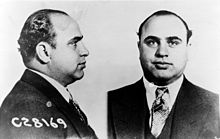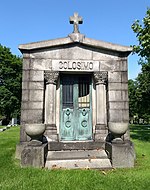| Big Jim Colosimo | |
|---|---|
 Colosimo c. 1915 Colosimo c. 1915 | |
| Born | Vincenzo Colosimo (1878-02-18)February 18, 1878 Colosimi, Calabria, Italy |
| Died | May 11, 1920(1920-05-11) (aged 42) Chicago, Illinois, U.S. |
| Cause of death | Gunshot wounds |
| Resting place | Oak Woods Cemetery, Chicago |
| Other names | "Big Jim", "Diamond Jim" |
| Occupation | Crime boss |
| Spouses |
|
| Allegiance | Chicago Outfit |
Vincenzo Colosimo (Italian: [vinˈtʃɛntso koˈlɔːzimo]; February 16, 1878 – May 11, 1920), known as James "Big Jim" Colosimo or as "Diamond Jim", was an Italian-American Mafia crime boss who emigrated from Calabria, Italy, in 1895 and built a criminal empire in Chicago based on prostitution, gambling and racketeering. He gained power through petty crime and heading a chain of brothels. From 1902 until his death in 1920, he led a gang known after his death as the Chicago Outfit. Colosimo was assassinated on May 11, 1920, and no one was ever charged with his murder. Johnny Torrio, an enforcer whom Colosimo imported in 1909 from New York, seized control of Colosimo's businesses after his death. Al Capone, a close associate of Torrio, has been accused of involvement in Colosimo's murder but was not yet in Chicago at the time.
Early years
Colosimo was born on February 16, 1878, to Luigi Colosimo and his second wife Giuseppina Mascaro in the town of Colosimi, Province of Cosenza, Italy. He emigrated from Italy to Chicago at the age of 17, starting out as a petty criminal. Colosimo attracted the attention of First Ward aldermen Michael "Hinky Dink" Kenna and John Coughlin. They made him a precinct captain and later their bagman. This gave Colosimo the political connections that helped him rise to power as a mob boss.
Prostitution empire
Later, Colosimo acquired another nickname, "Diamond Jim," because he frequently dressed in a white suit and wore diamond pins, rings, and other jewelry. This, combined with his charm and money, helped him establish relationships with women. He loved women and money, which fueled his enthusiasm for prostitution. In 1902, Colosimo married Victoria Moresco, an established Chicago madam and together they began expanding their prostitution business.
Among Colosimo's first brothels was The Victoria (named after his wife), on Archer and Armour Avenue, and The Saratoga, at Dearborn and 22nd Street. Within a few years, Colosimo had expanded this to nearly 200 brothels and had also made inroads into gambling and racketeering. Colosimo was reputedly making $50,000 ($720,000 in 2022) per month from his various legal and illegal operations.
Help from New York and expansion
By 1909, Black Hand extortion was a serious threat to Colosimo in Chicago. He brought in gangster John "The Fox" Torrio from Brooklyn and made him his second in command. Torrio was the nephew of Moresco. Laurence Bergreen states, "Torrio is described as Colosimo's nephew, but in the absence of any evidence to confirm the relationship, it is more likely their kinship was spiritual rather than familial." There are also references to Colosimo's wife being somehow related to John Torrio.
In 1910, Colosimo opened Colosimo's Cafe, a restaurant and nightclub at 2126 South Wabash. It quickly became a popular destination for prominent Chicagoans and visitors, gaining nationwide fame. Colosimo's crew grew into a multi-ethnic, hierarchical gang, with Italian, Irish, Polish, and Jewish gangsters. Colosimo's vice interests eventually expanded into Chicago's suburbs, including Burnham and South Chicago.
In 1919, Torrio and Colosimo opened a brothel at 2222 South Wabash called the Four Deuces, referencing the address. Torrio hired his old Brooklyn colleague Al Capone to work as a bartender and bouncer, which gave Capone his entry into Chicago crime.
Betrayal


When Prohibition went into effect in 1920, Torrio pushed for the gang to enter into bootlegging, but Colosimo stubbornly refused. In March 1920, Colosimo secured an uncontested divorce from Moresco. A month later, he and Dale Winter eloped to West Baden Springs, Indiana. Upon their return, he bought a home on the South Side. On May 11, 1920, Colosimo drove to Colosimo's Cafe to meet an associate he had never met before. He was shot and killed a few minutes after entering the restaurant by a gunman hiding in the cloak room. A bullet entered Colosimo's brain, behind his right ear. Contract killer Frankie Yale had allegedly traveled from New York to Chicago and personally killed longtime gang boss Colosimo at the behest of Torrio. Although suspected by Chicago police, Yale was never officially charged. Colosimo was allegedly murdered because he stood in the way of his gang making bootlegging profits, having "gone soft" after his marriage with Winter.
Colosimo was the first gang leader to organize the disparate parts of Chicago's crime scene. After his death, Torrio took over his gang, later to be replaced by Al Capone. His mob eventually became the infamous Chicago Outfit that ruled over some parts of the city.
Colosimo was interred at Oak Woods Cemetery in Chicago, in a lavish funeral witnessed by 5,000 mourners.
In popular media
Film
- In Scarface: The Shame of a Nation (1932), the death of "Big Louie" Costillo (Harry J. Vejar) is loosely based on Colosimo's assassination. Antonio "Tony" Camonte kills Big Louie at the behest of his friend Johnny Lovo, Costillo's right-hand man. Lovo was based on Johnny Torrio and Camonte on Al Capone, and the film presents Costillo's murder as the beginning of Lovo and Camonte's involvement in bootlegging, similar to how Colosimo's refusal to allow bootlegging is considered the primary reason for his murder.
- Joe De Santis played Colosimo in Al Capone (1959).
- Frank Campanella played Colosimo in Capone (1975).
Television
- Peter Siragusa portrayed Colosimo in the pilot episode of The Untouchables (1993).
- Colosimo and a fictionalized account of his murder was the subject of a 1993 episode of The Young Indiana Jones Chronicles, titled "Young Indiana Jones and the Mystery of the Blues." Colosimo was portrayed by Raymond Serra, Victoria Moresco by Linda Lutz, and Dale Winter by Jane Krakowski.
- Colosimo was portrayed by Peter Banks in a 1994 episode of In Suspicious Circumstances, titled No Witness, No Case (a reference to a prostitute whom Colosimo had sent from Chicago to Connecticut, who was murdered after she talked to the police).
- In 2010, Colosimo's murder was depicted in the series premiere of HBO's Boardwalk Empire. It depicts Colosimo, played by Frank Crudele, as the victim of a hit ordered by Torrio and committed by Frankie Yale to allow Torrio to go into bootlegging. He is shown being shot at the back of the head while listening to an Enrico Caruso record in his restaurant.
- He was portrayed by Andre King in the 2016 docuseries The Making of the Mob: Chicago.
Music
- In Ian Hunter's song "Resurrection Mary", the storyteller, who sees the infamous ghost of the title, used to do "the numbers for Big Jim."
Gaming
- In Mafia: Definitive Edition (2020), the mentioned offscreen murder of the Illinois mob boss Felice Peppone in 1922, by his two capos Ennio Salieri and Marcu Morello to get into the bootlegging business and form their own Mafia families in the city of Lost Heaven, is loosely inspired by the murder of Colosimo.
See also
References
- ^ ""Big Jim" Killed". The Mob Museum. Retrieved December 10, 2018.
- Bilek, Arthur J. (January 1, 2008). The First Vice Lord: Big Jim Colosimo and the Ladies of the Levee. Cumberland House Publishing. ISBN 9781581826395.
- ^ Bergreen, Laurence (1994). Capone: The Man and the Era. New York: Simon & Schuster. p. 81. ISBN 978-0-684-82447-5.
- ^ Sann, Paul. "The Roaring Twenties". The Lawless Decade. Retrieved December 10, 2018.
- ^ Capone: The Life and World of Al Capone by John Kobler
- ^ "When the Outfit Ran Chicago, Vol I: The "Big Jim" Colosimo Era". D&R (in Turkish). Retrieved December 10, 2018.
- Keefe, Rose (2003). Guns and Roses: The Untold Story of Dean O'Banion, Chicago's Big Shot Before Al Capone. Cumberland House Publishing. ISBN 978-1-58182-378-3.
- ^ Binder, John J. (2017). "Chapter 1". Al Capone's Beer Wars.
- ^ Sawyers, June (July 26, 1987). "The Vice Lord Who Fell in Love With a Choir Singer". Chicago Tribune. p. 163. Retrieved June 14, 2022 – via Newspapers.com.
- Schoenberg, pgs. 62-66
- Schoenberg, pgs. 62-65
Further reading
- Bilek, Arthur J. The First Vice Lord: Big Jim Colosimo and the Ladies of the Levee. Nashville: Cumberland House, 2008.
| American Mafia | ||
|---|---|---|
| Preceded byNew title | Chicago Outfit Boss 1910–1920 |
Succeeded byJohn Torrio |
| Italian-American Mafia | |||||||||||||||||||
|---|---|---|---|---|---|---|---|---|---|---|---|---|---|---|---|---|---|---|---|
| Families |
| ||||||||||||||||||
| Structure |
| ||||||||||||||||||
| Events |
| ||||||||||||||||||
| Closely related and affiliated organizations |
| ||||||||||||||||||
| Other topics |
| ||||||||||||||||||
| Prostitution in the United States | |||||||||||||
|---|---|---|---|---|---|---|---|---|---|---|---|---|---|
| Areas | |||||||||||||
| Brothels |
| ||||||||||||
| Law |
| ||||||||||||
| Media | |||||||||||||
| Organizations | |||||||||||||
| People |
| ||||||||||||
| Red-light districts |
| ||||||||||||
| Violence | |||||||||||||
| Other |
| ||||||||||||
- 1878 births
- 1920 deaths
- 1920 murders in the United States
- Al Capone associates
- American brothel owners and madams
- Chicago Outfit bosses
- Deaths by firearm in Illinois
- Italian crime bosses
- Italian emigrants to the United States
- Murdered American gangsters of Italian descent
- People from Cosenza
- People murdered by Italian-American organized crime
- People murdered in Illinois
- American gangsters of the interwar period
- Unsolved murders in the United States